Other Tools
This chapter describes miscellaneous tools provided for user convenience.
1. Overview
The following is a list of miscellaneous tools.
| Tool Name | Description |
|---|---|
Displays messages to the console on the shell prompt. |
|
Encodes the user password as a 64-byte character string. |
|
Analyzes JCL, PROCEDURE, and INCLUDE files. |
|
Analyzes MSP JCL and PROCEDURE. |
|
Displays information about configuration files used in OpenFrame. |
|
Displays an error number, error code and a brief error message for errors that occur in OpenFrame. |
|
Displays version information about all OpenFrame file components for version tracking purposes. |
|
Displays version information about the installed OpenFrame modules. |
|
Prevents user information from being duplicated. |
|
Provides a virtual OpenFrame console program corresponding to the Mainframe console. |
|
Displays the VTAM resource information imported to the database after the system startup. |
|
Parses a VTAM command entered by the user, and executes the parsed command. |
|
Displays the VTAM resource information stored in the database. |
|
Compiles the BEGINVTAM statement and saves the information to the database. |
2. conprt
The conprt tool displays messages in the console on the shell prompt. You can easily check the message from the console.
Usage
The conprt tool can be invoked as follows:
$ conprt [options] <message>-
[options]
The following describes each option for conprt. Each item is delimited by a space.
Option Description [-i|--console-id]
Specifies the console ID, with a number from 0 to 99. (Default value: 0)
[-s|--source]
Specifies the name of the source for a message. It can be a JCL, COBOL or PGM name. (Default value: CONSOLE)
[-u|--user]
Specifies the job ID or user ID for the message.
The [-u] option is valid only when the JOBID environment variable is not set. It is ignored if this variable is set. If neither the JOBID environment variable nor the [-u] option is set, an error occurs.
-
Input Items
Item Description message
Specifies the message to be displayed in the console.
Examples
The following example sends a message that reads 'CONSOLE DISPLAY TEST' with 'COBOL' and 'TEST' as the source name and user name respectively.
$ conprt -s COBOL -u TEST "CONSOLE DISPLAY TEST"Once the command is executed, the message "CONSOLE_DISPLAY_TEST" is displayed in the console.
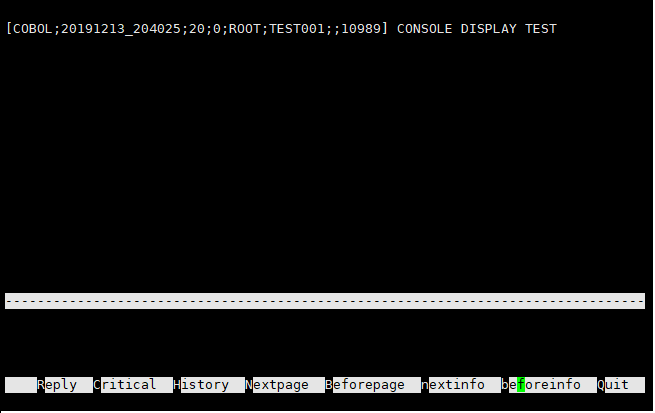
3. enpasswd
The enpasswd tool encodes the user password as a 64-byte string.
When using OpenFrame, you are occasionally required to enter your user password in a configuration menu. For example, you need to set some information such as database name, user name and password in the ikjeft01 subject under OpenFrame Configuration, in order to be able to access a specific RDBMS. Since the information in the configuration files can be easily viewed, the user ID and password must be encrypted.
|
For more information about OpenFrame Configuration, refer to OpenFrame Base Configuration Guide. |
Usage
The enpasswd tool can be invoked as follows:
Usage: enpasswd username password
-
Parameters
Parameter Description username
Specifies the encoding key for encrypting the password.
password
Specifies the password to be encrypted. After enpasswd is executed, the password encrypted in a 64-byte string will be displayed on the terminal.
Examples
The following example specifies the user ID as 'igkang' and the password as 'whoknows', and then executes enpasswd to print the encrypted password.
$ enpasswd igkang whoknows
970A3C79A0E803DCB62B276D91602D77500107695254FDA1BD477054AEBACBBD|
If an encrypted password and a non-encrypted password are both specified in the configuration file, the non-encrypted password will be chosen. To use an encrypted password, set the ikjeft01 subject in OpenFrame Configuration. |
4. mvsana
The mvsana tool analyzes MVS JCL, Procedure, and Include files. When you analyze a file with mvsana, it checks for any syntax errors and prints information about where and why the errors occurred.
|
mvsana is supported only in OpenFrame Batch for MVS. |
Usage
The mvsana tool can be invoked as follows:
$ mvsana [options] FILE_PATH-
[options]
The following describes each option for mvsana. Each option is delimited with a space.
Option Description [-N | --normal]
Prints the results of analysis in the default format.
[-C | --csv]
Prints the results of analysis in the CSV format.
[-P | --Procedure file]
Used when the specified file is a procedure file.
[-E | --ERROR]
Prints error to FILE_PATH.err.
[-d <directory-name> | --directory <directory-name>]
Sets the directory of the instream data file.
[-p <directory-name> | --procedure <directory-name>]
Sets the directory of the procedure.
[-i <directory-name> | --include <directory-name>]
Sets the directory of the include file.
[-e <filepath> | --error <filepath>]
Prints error to the specified file path.
[-pgm <program-name> | --pgm_sysin <program-name>]
Sets the program from which to get the SYSIN data.
[-f | --full_parsing]
Parses JCL, include, and procedure files and prints any syntax errors, missing files, unsupported functions, and successful analysis results. Unsupported functions are printed only for successful results.
[-ri <directory-name>]
Searches for include files in the specified directory and one level lower directory.
[-rp <directory-name>]
Searches for procedure files in the specified directory and one level lower directory.
-
Parameters
Parameter Descriptoin FILE_PATH
Specifies the path of the file to be analyzed.
Examples
The following example uses the [-N] option to analyze JCL.
$ mvsana -N ./ABC.jcl
--------------- ./ABC.jcl ERROR ----------
Syntax Error [Line:13 ;Column: ;Keyword: ;Message:INCLUDEed file(/home/user/oframe_7/volume_DEFVOL/SYS1.PROCLIB/AB) not found]
Syntax Error [Line:26 ;Column: ;Keyword: ;Message:INCLUDEed file(/home/user/oframe_7/volume_DEFVOL/SYS1.PROCLIB/CD) not found]
JCLNAME="ABC.jcl", JCLTYPE="MVS"The following example uses the [-P] option to analyze procedures for any errors.
$ mvsana -P ../SYS1.PROCLIB/TSTPROC/ABC
<JCL JCLNAME="ABC" JCLTYPE="MVS">
<JOB JOBNAME="ABC">
<STEP STEPNUMBER="1" STEPNAME="STEP1" PROCNAME="ABC" PROCTYPE="C" PROC_ID="1" FROM="../SYS1.PROCLIB/TSTPROC/ABC">
</STEP>
</JOB>
</JCL>The following example uses the [-f], [-ri] and [-rp] options to analyze JCL.
$ mvsana -f ./ABC.jcl -ri ../SYS1.PROCLIB -rp ../SYS1.PROCLIB
<ERROR SOURCE="./ABC.jcl">
<ERROR_TYPE CODE="3" ST_LINE="2" END_LINE="2" FROM="/home/user/oframe_7/volume_DEFVOL/SYS1.JCLLIB/ABC.jcl">
<MESSAGE STRING="Message:syntax error"/>
</ERROR_TYPE>
<ERROR_TYPE CODE="2" ST_LINE="39" END_LINE="39">
<MISSING TYPE="PROCEDURE" NAME="IKJEFT" STEPNAME="STEP02" FROM="/home/user/oframe_7/volume_DEFVOL/SYS1.JCLLIB/ABC.jcl">
<MESSAGE STRING="39 : IKJEFT IS NOT FOUND."/>
</MISSING>
</ERROR_TYPE>
</ERROR>5. mspana
The mspana tool analyzes MSP JCL and procedures. When you analyze a file with mspana, it checks for any syntax errors and prints information about where and why the errors occurred.
|
mspana is supported only in OpenFrame Batch for MSP. |
Usage
The mspana tool can be invoked as follows:
$ mspana [options] FILE_PATH-
[options]
The following describes each option for mspana. Each option is delimited with a space.
Option Description [-N | --normal]
Prints the results of analysis in the default format.
[-C | --csv]
Prints the results of analysis in the CSV format.
[-P | --Procedure file]
Used when the specified file is a procedure file.
[-E | --ERROR]
Prints error to FILE_PATH.err.
[-d <directory-name> | --directory <directory-name>]
Sets the directory of the instream data file.
[-p <directory-name> | --procedure <directory-name>]
Sets the directory of the procedure.
[-e <filepath> | --error <filepath>]
Prints error to the specified file path.
[-pgm <program-name> | --pgm_sysin <program-name>]
Sets the program from which to get the SYSIN data.
[--sysin-path-for-sort <filepath>]
Finds the SYSIN data set for SORT STEP in the specified file path and prints its content.
-
Parameters
Parameter Description FILE_PATH
Specifies the path of the file to be analyzed.
Examples
The following example uses mspana to analyze the JCL by specifying [-N] : normal, [-C] : CSV, [Default] : XML options.
$ cat TESTJOB.jcl
//TESTJOB JOB
//STEP01 EXEC PGM=KDJBR14
//DEL0TE01 DD DSN=TESTJOB.DATA.SDS01,DISP=(MOD,DELETE,DELETE)
//STEP02 EXEC PGM=KDJBR14
//CREATE01 DD DSN=TESTJOB.DATA.SDS01,DISP=(NEW,CATLG,DELETE),
// VOL=SER=DEFVOL,DCB=(LRECL=80,BLKSIZE=1040)
//$ mspana -N TESTJOB.jcl
JCLNAME="TESTJOB.jcl", JCLTYPE="MSP"
JOBNAME="TESTJOB"
STEPNAME="STEP01", PGMNAME="KDJBR14"
DDNAME="DEL0TE01", DSNAME="TESTJOB.DATA.SDS01", DISP="(MOD,DELETE,DELETE)"
STEPNAME="STEP02", PGMNAME="KDJBR14"
DDNAME="CREATE01", DSNAME="TESTJOB.DATA.SDS01", DISP="(NEW,CATLG,DELETE)",
DCB="(LRECL=80,BLKSIZE=1040)", VOLUME="DEFVOL"
$ mspana -C TESTJOB.jcl
TESTJOB.jcl,MSP,,1,TESTJOB,,STEP01,1,KDJBR14,"",DEL0TE01,TESTJOB.DATA.SDS01,
"(MOD,DELETE,DELETE)",,,,,,,,,,,,"",,,"","",,,
TESTJOB.jcl,MSP,,1,TESTJOB,,STEP02,1,KDJBR14,"",CREATE01,TESTJOB.DATA.SDS01,
"(NEW,CATLG,DELETE)",,,,,,,,,,,,"(LRECL=80,BLKSIZE=1040)",,,"","",,DEFVOL,
$ mspana TESTJOB.jcl
<JCL JCLNAME="TESTJOB.jcl" JCLTYPE="MSP">
<JOB JOBNAME="TESTJOB">
<STEP STEPNUMBER="1" STEPNAME="STEP01" PGMNAME="KDJBR14">
<DD DDNAME="DEL0TE01" DSNAME="TESTJOB.DATA.SDS01" DISP="(MOD,DELETE,DELETE)"/>
</STEP>
<STEP STEPNUMBER="2" STEPNAME="STEP02" PGMNAME="KDJBR14">
<DD DDNAME="CREATE01" DSNAME="TESTJOB.DATA.SDS01" DISP="(NEW,CATLG,DELETE)"
DCB="(LRECL=80,BLKSIZE=1040)" VOLUME="DEFVOL"/>
</STEP>
</JOB>
</JCL>The following example uses the [-P] option to analyze the procedure for any errors.
$ cat TESTPROC
//TESTPROC PROC
//PRSTEP01 EXEC PGM=KEQEFT01,DYNAMNBR=25,REGION=2048K
//SYSPRINT DD TERM=TS,SYSOUT=A
//SYSIN DD TERM=TS
//$ mspana -P TESTPROC
<JCL JCLNAME="TESTPROC" JCLTYPE="MSP">
<JOB JOBNAME="TESTPROC">
<STEP STEPNUMBER="1" STEPNAME="STEP1" PROCNAME="TESTPROC" PROCTYPE="C" PROC_ID="1">
</STEP>
<STEP STEPNUMBER="2" STEPNAME="PRSTEP01" PGMNAME="KEQEFT01" PARENT_PROC_ID="1">
<DD DDNAME="SYSPRINT" SYSOUT="A"/>
<DD DDNAME="SYSIN"/>
</STEP>
</JOB>
</JCL>6. ofconfig
Manages OpenFrame configuration item values.
From OpenFrame 7.1, configurations are stored in a database and then loaded in TCache of each node at runtime. Configurations are set with nodes, subjects, sections, and keys. If a setting value is modified with a command of ofconfig, the change is automatically synchronized by a TCache server. However, if a user directly accesses a database and modifies a setting value without using an OpenFrame function, the change must be applied by executing the LOAD command. Note that the DELETE command completely deletes the setting value of a specified key.
Usage
Usage: ofconfig command [options]
-
Input parameters
Parameter Description command
-
ADD: Adds a new configuration item.
-
LIST: Retrieves configuration information.
-
UPDATE: Modifies a configuration item.
-
IMPORT: Imports configuration information from a dump file. Duplicate setting values for the same configuration item are modified.
-
EXPORT: Exports configuration information to a dump file.
-
LOAD: Applies configuration information to TCache.
-
TRUNCATE: Deletes all configuration item values.
-
DELETE: Deletes the setting value of a specified key.
-
-
[options]
The following describes each option for each command.
-
ADD
Option Description [-n nodename]
Node name.
[-s subject]
Subject name.
[-sec section]
Section name.
[-k key]
Key name.
[-t type]
Value type of the configuration item.
-
1: Either YES or NO
-
2: String
-
3: Number
[-d default_value]
Default value.
[-v value]
Setting value.
[-a avail_value]
Available value or range.
[-desc description]
Description about the configuration item.
-
-
LIST
Option Description [-n nodename]
Node name to retrieve.
[-s subject]
Subject name to retrieve.
[-sec section]
Section name to retrieve.
[-k key]
Key name to retrieve.
[-l long_format]
Displays detailed information.
-
UPDATE
Option Description [-n nodename]
Node name.
[-s subject]
Subject name.
[-sec section]
Section name.
[-k key]
Key name to modify.
[-v value]
New setting value.
[-desc description]
Description about the configuration item.
-
IMPORT
Option Description [-f file]
File to import.
-
EXPORT
Option Description [-n nodename]
Node name from which the configuration is exported.
[-f file]
File to export.
-
TRUNCATE
Option Description [-n nodename]
Node name to initialize the configuration.
-
DELETE
Option Description [-n nodename]
Name of the node that includes the key whose setting value will be deleted.
[-s subject]
Name of the subject that includes the key whose setting value will be deleted.
[-sec section]
Name of the section that includes the key whose setting value will be deleted.
[-k key]
Key whose setting value will be deleted.
-
Examples
The following defines a new configuration item to a node named NODE1. The DEFAULT_VOLSER key is set to DEFVOL in the DATASET_DEFAULT section of the ds subject as a string.
$ ofconfig add -n NODE1 -s ds -sec DATASET_DEFAULT -k DEFAULT_VOLSER -t 2 -d DEFVOL -v DEFVOL -desc "default volume serial."The following retrieves the value of the DEFAULT_VOLSER key in NODE1.
$ ofconfig list -n NODE1 -s ds -sec DATASET_DEFAULT -k DEFAULT_VOLSER
=====================================================================================
SUBJECT | SECTION | KEY | VALUE
=====================================================================================
ds | DATASET_DEFAULT | DEFAULT_VOLSER | DEFVOL
=====================================================================================The following modifies the value of the DEFAULT_VOLSER key in NODE1.
$ ofconfig update -n NODE1 -s ds -sec DATASET_DEFAULT -k DEFAULT_VOLSER -v 100001The following deletes the setting value of DEFAULT_VOLSER in NODE1.
$ ofconfig delete -n NODE1 -s ds -sec DATASET_DEFAULT -k DEFAULT_VOLSER|
For detailed information about configuration items, refer to OpenFrame Base Configuration Guide. |
7. oferror
The oferror tool displays the error number, error code and error messages, as well as adds new error codes for errors that occur in an OpenFrame application. When retrieving multiple error codes through oferror, delimit each one with a space.
Usage
The oferror tool can be invoked as follows.
Usage: oferror [ERRORNO]|[insert [-p path]]
-
Parameters
Parameter Description ERRORNO
Specifies the number of the error to be displayed.
insert [-p path]
Specifies the path of the error message file to be added.
Examples
The following example retrieves an error with the error number -1002.
$ oferror -1002
/*
/* error no : -1002
/* error code: TSAM_ERR_DUPLICATE_KEY
/* error msg : duplicate key
/*The following example tried to retrieve a non-existing error.
$ oferror 23132
Not defined error no: 23132The following example adds an error code.
$ oferror insert –p errcode_base.msg8. offile
The offile tool provides version and build information about the file modules of OpenFrame.
The following information is displayed.
-
Module version information
Module version information is printed to the stdout stream (standard output) in the following format.
{major}.{minor}.{patch}(module build number) -
Module build information
Module build information is printed to the stdout stream (standard output) in the following format.
{id}{hostname}/{source tree}(#{product build number}) {date} {time}
Usage
The offile tool can be invoked as follows:
Usage: offile module1 [module2 ...]
-
Parameters
Parameter Description module1
Displays version and build information about the specified module to stdout.
[module2 …]
Displays version and build information about multiple modules at once.
Examples
The following example displays the version and build information of the tjesmgr OpenFrame Batch module from the $OPENFRAME_HOME/bin directory.
$ offile ${OPENFRAME_HOME}/bin/tjesmgr
tjesmgr version 7.1.0(0), tmax@tgumdev:oframe_7_1_src/batch(#2) 2019-10-21 10:47:37The following example displays version and build information for all modules in the $OPENFRAME_HOME/bin directory that have names ending with 'ana'.
$ offile *ana
ikjana version 7.1.0(0), tmax@tgumdev:oframe_7_1_src/base(#1) 2019-10-21 10:16:42
mspana version 7.1.0(0), tmax@tgumdev:oframe_7_1_src/base(#1) 2019-10-21 10:16:42
mvsana version 7.1.0(0), tmax@tgumdev:oframe_7_1_src/base(#1) 2019-10-21 10:16:429. ofversion
The ofversion tool displays version information about the OpenFrame modules that are installed on a platform.
Usage
The ofversion tool can be invoked as follows:
Usage: ofversion
Examples
The following example executes the ofversion command on a platform where only OpenFrame/Base is installed.
$ ofversion
ofversion version 7.1.0(0) tmax@tgumdev:oframe_7_1_src/base(#1) 2019-10-21 10:16:42
Print OpenFrame Version Information
OpenFrame Solution is Composed of
- OpenFrame/Base 7.1 64bit
- OpenFrame/Batch MSP 7.1 64bit
- OpenFrame/TACF 7.1 64bit10. tacflogin
The tacflogin tool prevents user information from being duplicated, and simplifies the login process. While using OpenFrame, the user may be required to enter the password for authentication in a command line or a configuration file. To prevent user information from being duplicated, the tacflogin tool verifies if the USERID, GROUPNAME, and PASSWORD are valid information, and encodes them. The tool then stores the information as a file in the directory set in the TACFPASS environment variable of the corresponding shell. If the variable is not set, the default value is the UNIX user’s home directory. When accessing TACF, OpenFrame decodes and uses user information stored in the directory set in the TACFPASS environment variable.
The log-in unit of tacflogin is a user. The log-in status of the user who logged in through tacflogin is kept until the user explicitly logs out through the tool. This means that even though multiple ssh sessions exist between log-in and log-out through tacflogin, the log-in status can be kept the same.
OpenFrame modules requiring the user’s log-in access TACF through the library that read the user’s information from his/her home directory. If the information has not been stored by tacflogin, the user will be required to enter such information in a conversation format.
Log-in through tacflogin is processed as follows:
-
Logs into tacflogin by entering USERID, GROUPNAME, and PASSWORD with the -i option.
-
The user directly enters USERID, GROUPNAME, and PASSWORD to log in. However, if the VALUE of the ASKGRPNM key is set to NO, in the AUTH_OPTION section of the saf subject under OpenFrame, the user is not required to enter GROUPNAME.
The following figure demonstrates how user information stored by tacflogin is used.
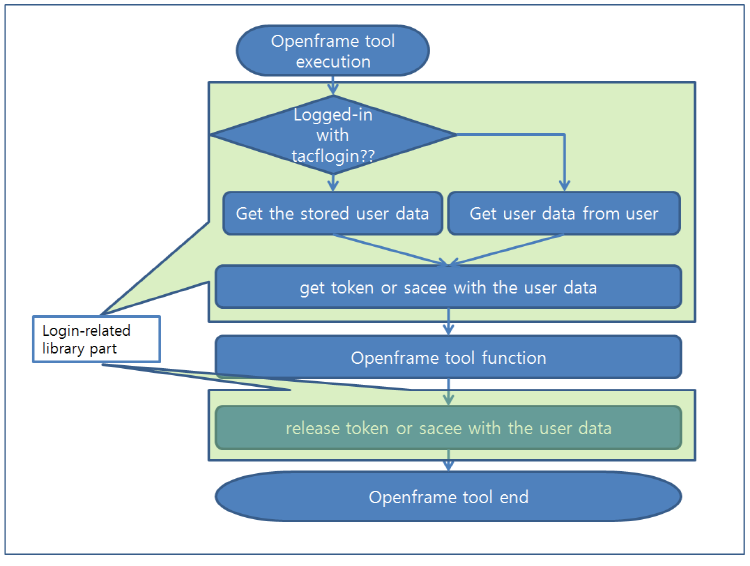
Usage
The tacflogin tool can be invoked as follows:
Usage: tacflogin [options]
-
[options]
Option Description [-i]
Specifies user information under the format of -iUSERID[GROUPNAME]/PASSWORD, and the information is used for log-in. If 'GROUPNAME' is not specified, the user will be required to enter the name of the group. If the group name is omitted, the information can be specified as -iUSERID[]/PASSWORD. In this case, the name of the group to access TACF will be regarded as that of the default group specified when the TACF user was created.
[-o]
Delete user information when logging out.
[-l]
Displays the currently connected ID.
[-h]
Displays help information for tacflogin.
no option
Asks for the user information in the form of a dialog, if no option is specified.
Examples
The following example specifies 'TEST01' for USERID, and 'abcde' for PASSWORD:
$ tacflogin -iTEST01/abcde
Input GROUPNAME :
Logged-in as [TEST01]11. tconmgr
The tconmgr tool is a virtual OpenFrame console program which corresponds to a mainframe console. Execute tconmgr to see a console message of the user-preferred ID.
Usage
The tconmgr tool can be invoked as follows:
$ tconmgr [CONSOLE_ID]-
Input Parameters
Parameter Description CONSOLE_ID
Specifies a number from 0 to 99. OpenFrame currently uses only 0, and if CONSOLE_ID is not specified, 0 is specified by default. All messages of the output parameter list are also displayed as 0.
-
Output Parameters
The following is output to the first part of a message. Each parameter is delimited with a semicolon(;), and all the parameters are enclosed by squared brackets([ ]).
Parameter Description Msg Source
Specifies the message source such as COBOL and TCONMGR.
Date Time
Specifies the date and time when the message is created. (Format: YYYYMMDD_HHMMSS)
Length
Specifies the length of the message.
Console ID
Specifies the console ID of the message source. Currently, only zero is printed.
User
Specifies generally the JOBID of the message source, or user name if no JOBID. If the message source is TCONMGR, the JOBID of the response target is displayed.
Process ID
Specifies the Unix PID of the message source. If the message source is TCONMGR, the Unix PID of the response target is displayed.
Examples
The following example, a general flow of a console, shows how an application sends a message to a console or requests a response.
IDENTIFICATION DIVISION … ENVIRONMENT DIVISION … DATA DIVISION … WORKING-STORAGE SECTION. 03 BUFFER PIC X(10). PROCEDURE DIVISION. A SECTION. DISPLAY “CONSOLE DISPLAY TEST” UPON CONSOLE. ACCEPT BUFFER FROM CONSOLE. EXIT. STOP RUN
DISPLAY and ACCEPT are executed as follows:
-
Execute DISPLAY with the following command.
DISPLAY “CONSOLE_DISPLAY_TEST” UPON CONSOLE.
The message "CONSOLE_DISPLAY_TEST" will be displayed to a console.
 Result of DISPLAY
Result of DISPLAY -
Execute ACCEPT with the following command.
ACCEPT BUFFER FROM CONSOLE.
The message "Accept request received!!!" will be displayed.
 Result of ACCEPT
Result of ACCEPT -
The user can respond to the message with the REPLY command, 'R'. Execute 'R', and a new page displaying a list of messages requesting a response will appear. The user can respond to the message by choosing a desired number.
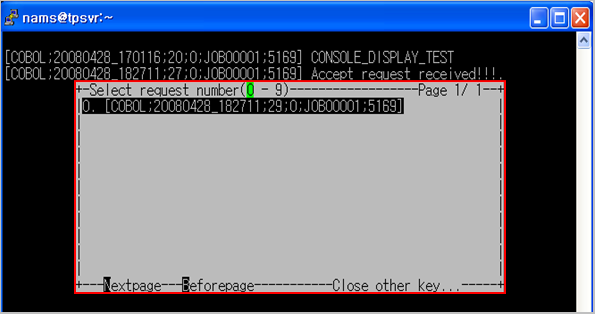 Result of REPLY
Result of REPLY -
If selecting 0 from the message list and responding to the message with an 'OK' message, the following screen will be displayed.
 After Executing OK (1)
After Executing OK (1) -
Then a message that tconmgr responded to the message will be displayed, as follows.
 After Executing OK (2)
After Executing OK (2)
If closing tconmgr, the contents will be removed from the screen. To search for the previous contents, use a HISTORY command with 'H', as follows.
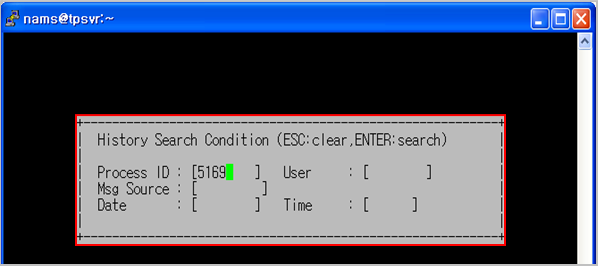
If executing 'H', a new screen will appear, and previous contents will be searched with the following conditions.
| Item | Description |
|---|---|
Process ID |
UNIX PID |
User |
Generally the JOBID of the message source, or different name if no JOBID. |
Msg Source |
Message source such as COBOL and TCONMGR. |
Date |
Date when the message is created. If no data is entered, any contents created on the day are searched. |
Time |
Time when the message is created. Only the messages created after the specified time are searched. |
For instance, if searching data with Process ID, 5169, the following screen will be displayed.
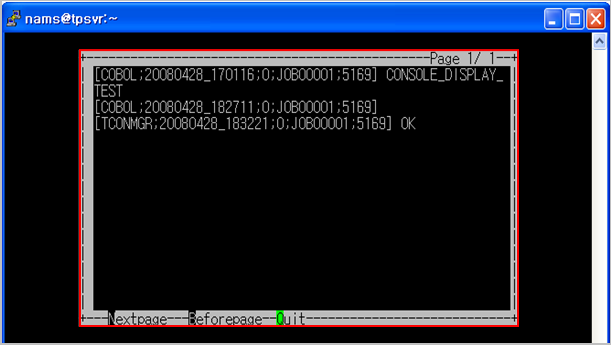
12. vtamadm
The vtamadm tool displays the VTAM resource information stored in the VTAM database after the system startup.
Usage
The vtamadm tool can be invoked as follows:
OpenFrame VTAM Admin Tool
Usage: vtamadm [options1]
options1:
-l Display active LU list of VTAM
-d Display resource list of VTAM
-w Display VTAM Gateway list
-f {gateway name} Remove VTAM Gateway information from DB forcely
Warning: Be careful to use this option !!
-r {LU} Remove active LU of VTAM specified forcely
Warning: Be careful to use this option !!
-h Display this information
-v Display version information
-
[options1]
Option Description [-l]
Displays the information of the currently connected terminal.
[-f] {gateway name}
Deletes the specified gateway information from the database.
[-w]
Displays the information of currently running OpenFrame GW.
[-d]
Displays the VTAM resource information.
[-r] {LU}
Disconnects forcefully the currently connected terminal.
[-h]
Displays help information for the tool usage.
[-v]
Displays vtamadm version information.
It is recommended to use the [-r] <LU> option only when the terminal information is invalid during a network failure.
Examples
The following example displays VTAM resources information with vtamadm.
$ vtamadm -d
VTAM IP-LU mapping resource Information
========================================================================================
PORT IPGROUP RANGE(BEGIN..END) IP
----------------------------------------------------------------------------------------
18100 IPGPAY B:192.168.33.1 E:192.168.34.255
========================================================================================
PORT GROUP TYPE GROUP NAME RANGE(BEGIN..END..RULE) LU
----------------------------------------------------------------------------------------
18100 LUGROUP LUGRP B:OIVPTRM1 E:OIVPTRM9 R:FFFFFFFN
========================================================================================
PORT GROUP TYPE GROUP NAME RANGE(BEGIN..END..RULE) LU
----------------------------------------------------------------------------------------
18100 DEFAULTLUS B:TCP00081 E:TCP00099 R:FFFFFFNN
========================================================================================
PORT MAP TYPE LUGROUP CLIENT ID DEFAULT APPLID OPTIONS
----------------------------------------------------------------------------------------
18100 LUMAP LUGRP IPGPAY IMSA SPECIFIC
========================================================================================The following example displays the currently connected terminal information by using the -l option with vtamadm. USERID is the ID of the currently logged in user.
$ vtamadm -l
Active LU information connected to VTAM
==========================================================================================================
NO. LU TYPE CLID NODENAME IP_ADDR LOGON_REGION USERID
----------------------------------------------------------------------------------------------------------
1 OSC00001 OSC REGION NODE1
2 OIVPTRM1 IBM-3278-2-E 5 NODE1 192.168.33.33 OSC00001 ROOT
3 TSO TSO NODE1
==========================================================================================================13. vtamcmd
The vtamcmd tool parses a VTAM command entered by the user and then executes the parsed command.
Usage
The vtamcmd tool can be invoked as follows:
OpenFrame VTAM Command Execution Tool
Usage: vtamcmd [options]
Options:
-c <VTAM command> Specify VTAM command and options
-h Display this information
-v Display version information
Example:
$ vtamcmd -c 'DISPLAY NET,TERMS'
$ vtamcmd -c 'VARY NET,ACT,ID=TESTTRM1'
$ vtamcmd -c 'VARY NET,INACT,ID=TESTTRM1'
$ vtamcmd -c 'CLEAR NET,INACT,ID=TESTTRM1'
-
[options]
Option Description [-c <VTAM command>]
Specifies a VTAM command.
-
DISPLAY NET: Displays the status of terminals or terminal groups registered in VTAM.
-
VARY NET: Enables or disables a specific terminal.
-
CLEAR NET: Removes some unwanted information from the list of information to be displayed with the DISPLAY command.
[-h]
Displays help information for the tool usage.
[-v]
Displays vtamcmd version information.
-
13.1. DISPLAY NET
Displays the status of terminals or terminal groups registered in VTAM. You can simply enter D as an abbreviation for DISPLAY.
-
Usage
-+-DISPLAY-+-NET-,TERMS- '-D-------'
-
Examples
The following example displays the inactive status of a terminal TESTTRM1.
vtamcmd -c 'DISPLAY NET,TERMS'
1. INACT ID LIST ========================================================================================= NO. ID TYPE STATUS ----------------------------------------------------------------------------------------- 1 TESTTRM1 LU INACT ========================================================================================= 2. ACT ID LIST ========================================================================================= NO. ID TYPE STATUS ----------------------------------------------------------------------------------------- ========================================================================================= DISPLAY COMMAND COMPLETE
13.2. VARY NET
Enables or disables a specific terminal. If disabled, the terminal sends no input to the server. You can simply enter V as an abbreviation for VARY.
-
Usage
-+-VARY-+-NET-+-,ACT---+-,ID=termid- '-V----' '-,INACT-'
Operand Description ACT | INACT
Enables (Activate) or disables (deactivate) a terminal or terminal group.
termid
Specifies the name of a terminal or terminal group to activate or deactivate.
-
Examples
The following example disables a terminal TESTTRM1.
vtamcmd -c 'VARY NET,INACT,ID=TESTTRM1'
|
When this command is used while terminal TESTTRM1 is connected, the terminal will be disconnected. |
13.3. CLEAR NET
Removes some unwanted information from the list of information to be displayed with the DISPLAY command. Any terminal or terminal group removed through the CLEAR command becomes activated. You can simply enter CL as an abbreviation for CLEAR.
|
Only a terminal or terminal group displayed through the DISPLAY command can be removed. |
-
Usage
-+-CLEAR-+-NET-+-,ACT---+-ID=termid- '-CL----' '-,INACT-'
Operand Description ACT | INACT
Specifies whether the terminal or terminal group to remove is active or inactive.
termid
Specifies the name of the terminal or terminal group to remove.
-
Examples
The following example deletes information of an inactive terminal TESTTRM1, and activates it.
vtamcmd -c 'CLEAR NET,INACT,ID=TESTTRM1'
The following example retrieves the information of an inactive terminal group LUGRP1, and activates it.
vtamcmd -c 'DISPLAY NET,TERMS'
1. INACT ID LIST ========================================================================================= NO. ID TYPE STATUS ----------------------------------------------------------------------------------------- 1 LUGRP1 LUGRP INACT ========================================================================================= 2. ACT ID LIST ========================================================================================= NO. ID TYPE STATUS ----------------------------------------------------------------------------------------- ========================================================================================= DISPLAY COMMAND COMPLETE
vtamcmd -c 'CLEAR NET,INACT,ID=LUGRP1'
14. vtamdump
The vtamdump tool displays the VTAM resource information stored in the VTAM database.
Usage
The vtamdump tool can be invoked as follows:
VTAM Definition Dump Utility
Usage: vtamdump [<file>]
| vtamdump [-h | -v]
<file> Specify output file name
-h Display this information
-v Display version information
-
Parameters
Parameter Description file
Specifies the file containing the VTAM resource information to display.
-
[options]
Option Description [-h]
Displays help information for the tool usage.
[-v]
Displays vtamdump version information.
15. vtamgen
The vtamgen tool compiles the BEGINVTAM macro and save the information to the VTAM database.
|
For information about how to use the BEGINVTAM macro, refer to "Chapter 3. LU Automatic Allocation" in OpenFrame GW Administrator’s Guide. |
Usage
The vtamgen tool can be invoked as follows:
VTAM Definition Generator
Usage: vtamgen <file>
| vtamgen [options]
<file> Specify definition script file
Options:
-h Display this information
-v Display version information
-
Parameters
Parameter Description file
Specifies a text file in which the BEGINVTAM statement is defined.
-
[options]
Option Description [-h]
Displays help information for the tool usage.
[-v]
Displays vtamgen version information.